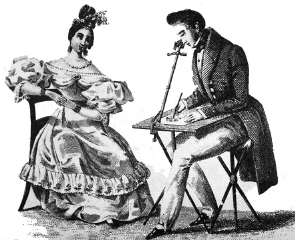Camera lucida
From Wikipedia, the free encyclopedia

A camera lucida is an optical device used as a drawing aid by artists.
The camera lucida performs an optical superimposition of the subject being viewed upon the surface upon which the artist is drawing. The artist sees both scene and drawing surface simultaneously, as in a photographic double exposure. This allows the artist to duplicate key points of the scene on the drawing surface, thus aiding in the accurate rendering of perspective. At times, the artist can even trace the outlines of objects.
Contents |
[edit] History
The camera lucida was patented in 1807 by William Hyde Wollaston. There seems to be evidence that the camera lucida was actually nothing but a reinvention of a device clearly described 200 years earlier by Johannes Kepler in his Dioptrice (1611).[citation needed] By the 19th century, Kepler’s description had totally fallen into oblivion, so Wollaston’s claim was not challenged. The term "camera lucida" is Wollaston's. (cf. Edmund Hoppe, Geschichte der Optik, Leipzig 1926)
While on honeymoon in Italy in 1833, the photographic pioneer William Fox Talbot used a camera lucida as a sketching aid. He later recorded that it was a disappointment with his resulting efforts which encouraged him to seek a means to "cause these natural images to imprint themselves durably".
In 2001, artist David Hockney's book Secret Knowledge: Rediscovering the Lost Techniques of the Old Masters, was met with controversy. His argument, known as the Hockney-Falco thesis, is that great artists of the past, such as Ingres, Van Eyck, and Caravaggio did not work freehand, but were guided by optical devices, specifically an arrangement using a concave mirror to project real images. His evidence is based entirely on the characteristics of the paintings themselves.
The camera lucida is still available today through art-supply channels, but is not well-known or widely used.
[edit] Description
The name "camera lucida" (Latin for "lit room") is obviously intended to recall the much older drawing aid, the camera obscura (Latin for "dark room"). There is no optical similarity between the devices. The camera lucida is a light, portable device that does not require special lighting conditions. No image is projected by the camera lucida.
In the simplest form of camera lucida, the artist looks down at the drawing surface through a half-silvered mirror tilted at 45 degrees. This superimposes a direct view of the drawing surface beneath, and a reflected view of a scene horizontally in front of the artist. The instrument often includes a weak negative lens, creating a virtual image of the scene at about the same distance as the drawing surface, so that both can be viewed in good focus simultaneously.
If white paper is used with the camera lucida, the superimposition of the paper with the scene tends to wash out the scene, making it difficult to view. When working with a camera lucida it is often beneficial to use black paper and to draw with a white pencil.
The camera lucida that commercial comprehensive ("comp") layout artists used from the early 1950's to late 1980's used lenses positioned over a platform where the original reference material (like a photo) was placed. A bellows arrangement and two cranks allowed the artist to expand or reduce the size of the image. The artist could step up and place her head under a shade canopy to see the image. The image was projected upward onto a sheet of glass parallel to the floor, where the artist could place a translucent sheet of white layout paper on which to draw. This machine provided the artist a means of quickly and accurately drawing products and of using other photos in the composition.
[edit] Microscopy
As recently as a few decades ago the camera lucida was still a standard tool of microscopists. Until very recently, photomicrographs were expensive to reproduce. Furthermore, in many cases, a clear illustration of the structure that the microscopist wished to document was much easier to produce by drawing than by micrography. Thus, most routine histological and microanatomical illustrations in textbooks and research papers were camera lucida drawings rather than photomicrographs.
[edit] See also
[edit] References
| This article does not cite any references or sources. Please help improve this article by adding citations to reliable sources. Unverifiable material may be challenged and removed. (March 2008) |


